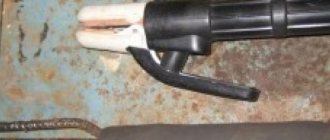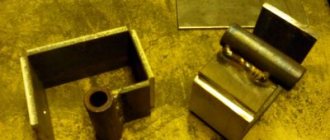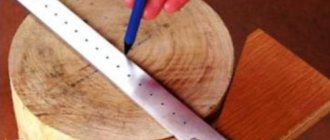How to make a nail puller with your own hands
How often do you have to work pulling nails and various pieces of iron out of wood? Of course, the perfect tool for this job is a nail puller.
However, you can completely refute this if you make such a useful homemade product for your home, which will allow you to pull out a nail or a stuck screw in wood in a matter of seconds. To make a useful tool for carpenters that allows them to quickly pull out nails, welding will be necessary. However, we won’t get too far ahead of ourselves, but consider everything in order and using a specific example.
Design and purpose of a nail puller
There is no person who can perfectly drive nails into any surface without making a single mistake. The percentage of errors made, of course, depends on the experience of the worker, but never drops to zero. Therefore, you can’t do without a nail puller on a construction site. In addition, quite often it is required not during the construction process, but to carry out the destruction of, for example, a wooden building. Many people burn the remains of a rotten building and use the ash, but construction nails in it will ruin all the properties, so they are removed first.
It is not always easy to remove a nail with small pliers, especially if the material is quite strong and the nail is long. This is where school physics and the law of leverage come to the rescue. Even the most stubborn nail can be reached without much effort if you have a long lever with a firm grip on the end. From here it is easy to guess about the design of the nail puller, which is quite simple. A correctly pointed end of the gripper will help pry up even the most deeply driven nail.
In general, our tool looks something like this: a long handle, at the end of which there is a bend, ending in a flattened forked tip with a slot . The length of the tool depends on the severity of the tasks that it can perform; this is the same length of the lever, which is directly related to the effort expended to pull out the nail. The pointed end easily fits under the nail head, which may not even protrude above the surface of the material. The slot firmly grips the head, and the bend as a stop allows you to smoothly move the center of gravity of the tool slightly back so that the pointed end rises, dragging the nail along with it.
Thus, without unnecessary sudden movements and enormous efforts, you will get any unsuccessful or unwanted fasteners. We have already said that most often we can find a nail puller as an additional head on a hammer. For most household work, this is quite sufficient and convenient; it can be removed immediately at the moment of hammering a nail. The hammer handle is long enough for leverage. But for more serious work, loaders and carpenters always have individual tools, made from high-strength materials. A nail puller is often used for more than just pulling nails, especially if it is highly durable.
Claw crowbar - the best carpentry and joinery tools for home use
A crowbar nail puller is a convenient device for removing nails from various structures. It makes it much easier for the technician to carry out dismantling work. Helps resolve the issue of removing nails quickly and efficiently. In turn, this is an ergonomic tool, despite the fact that it belongs to the category of a manual device, there are also models of an electric nail puller
If you pay attention to the photo of a nail puller, you can understand that this tool is a curved wedge with a forked end, with the help of which the head of the nail or other element being removed is captured. It is made exclusively from high quality metal and has a long shoulder.
Scope of application
Despite the simple design, the use of the tool is necessary in the construction industry.
It is used wherever the task is to remove objects from different surfaces, and it also greatly helps loaders lift heavy loads. It is used by carpenters, mechanics, and builders to solve everyday problems.
Also, the nail puller can be used not for its intended purpose, but for the reconstruction of a room, dismantling unnecessary structures and frames.
Varieties
In the classic version, the tool has the form of a rod made of steel with cut ends, and they can be on both sides of the nail puller.
The length of the standard device is from four hundred to five hundred millimeters, the diameter is from ten to twenty-five millimeters. If the length of the product increases, then the strength also increases due to the thickness, although the weight increases.
One type of tool is a hammer with a nail puller function. It has a short handle, making it mobile to use. This is a very versatile type of device, since the claw hammer can not only remove elements, but also hammer.
Titanium nail puller – how to buy a good tool?
Looking at the design, it seems that choosing such a tool is as easy as pie. But if you are an experienced master, then you will be very demanding in your approach to the matter. In addition, the range of seemingly monotonous devices is quite wide. For example, just by length you can expect to find a purchase from 32 cm to 1 m, weight can reach as much as 4 kg, although the lightest options will only pull 0.5 kg. The material used for manufacturing also differs; most often, it is high-carbon steel, but titanium nail puller is considered the leader in strength.
What will we work on?
Tools that have already become familiar in the household:
We will add an anvil, a gas cutter (included) and a powerful vice.
All this can be borrowed, or better yet, purchased. On the farm, such universal devices will come in handy more than once.
An anvil can be made from a regular rail. We use a grinder to form a point on one side of the cut rail, then use a drill to drill holes for fastening and a working hole, you will see what it is for later.
Dies and (or) a set of dies with a holder will significantly expand your capabilities
for threads M10 ÷ 18.
You can’t do without hand tools:
- hammer and small sledgehammer “fist”;
- pliers;
- metal scissors;
- pliers (you can use regular carpenter's pliers).
How to make a nail puller with your own hands - step-by-step diagram
Step 1: Preparing the nozzle
To do this, you will need steel wires of different diameters; for the smallest nails 0.5 mm is enough, but for heavy work you can even take reinforcement. The tip should be treated first. To do this, flatten the end with a hammer on an anvil (for reinforcement, you should not flatten it, you just have to cut the material to the desired sharpness, you can do it on an emery wheel). Next, use a regular hacksaw to cut a slot of moderate depth. Too long will force us to drive the nail deep into it, and this is not at all necessary, extra work.
We process metal, hardening
Before we find out what can be done on the farm using the simple set described above, let’s understand some of the properties of the metal.
Various rolled products, fittings, parts from mechanisms, that is, almost any steel accessible to the average person, becomes pliable and ductile when heated strongly. It can be flattened, bent and twisted in any way you like.
However, after the metal has cooled, it often becomes more ductile than it was before, but less hard and durable. This is especially noticeable when you work with springy steels, for example, a car spring.
The reason is the slow cooling of the workpiece during operation, during which the so-called “tempering” occurs. To restore the metal's hardness and strength again, it must be hardened, i.e. reheat and cool quickly.
I recommend: How to cut a thread with a die or tap, incl. on pipes
Heating, tempering and hardening are the main operations in the manufacture of knives, various staples, nails and similar products requiring hardness and strength.
Nail gun energy source
The main parameter of nailers is the source of force of the striker. Nail guns can be divided into the following types:
- Electrical
- Pneumatic
- Gas
- Under the patronage of Flaubert
There are no bad or good nailers among the nailers listed above. Each type of nail gun is good in a specific area.
Now let’s learn more about the types of nailers.
- Electric nail gun – these are usually household models. Although among electric nailers there are also professional nail guns that are applicable in production conditions.
As a rule, in such models the striker is fed under the influence of an electromagnetic field. The striker pops out at high speed, which allows the necessary force to be transferred to the nail.
Electric models are very reliable . But the current-carrying cord will not only get in the way under your feet and hands, but will also significantly limit the free movement of the nailer for driving nails.
This is just the beginning
Mastering the described techniques for working with metal will allow you to produce not only utilitarian objects, tools or fasteners. The same methods will allow you to create complex shaped elements. By fastening them with small forged clamps, or connecting them by welding, you will be able to assemble real forged masterpieces, which you can easily show off among your friends!
Don't forget about safety. Canvas mittens, durable shoes, and safety glasses will protect you from injury and burns.
Leave your tips and comments below. Subscribe to our newsletter. Good luck to you and good luck to your family!











